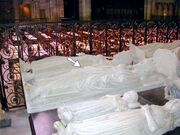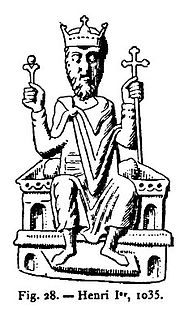| Wikipedia | |||||
| |||||
- King of France
- Duke of Burgundy
- Henry the Liberal
- Henry the Fowler
Henry I the Old Capet of France, King of France, Duke of Burgundy, was born 4 May 1008 in Reims, Marne, Grand Est, France to Robert II of France (972-1031) and Constance of Arles (986-1034) and died 4 August 1060 Vitry-aux-Loges, Loiret, Centre-Val de Loire, France of unspecified causes. He married Mathilde von Friesland (c1024-1044) . He married Anna Yaroslavna of Kiev (c1028-1075) 19 May 1051 JL .
Biography
King Henry I of France, also known as Henry the Fowler or Henry the Liberal, was born on May 4, 1008, in Reims, France. He was the son of King Robert II of France and his third wife, Constance of Arles (986-1034). Henry became King of France in 1031, after the death of his father.
During his reign, Henry faced several challenges, including conflicts with the Holy Roman Empire and rebellions from his own vassals. He also had to deal with Viking raids along the coast of France. The Crown lands of France (royal demesne) reached its smallest size during his reign, and for this reason he is often seen as emblematic of the weakness of the early Capetians. This is not entirely agreed upon, however, as other historians regard him as a strong but realistic king, who was forced to conduct a policy mindful of the limitations of the French monarchy. Despite the royal acquisition of a part of the County of Sens in 1055, the loss of Burgundy in 1032 meant that Henry I's twenty-nine-year reign saw feudal power in France reach its pinnacle.
Despite these challenges, Henry is remembered as a just and wise ruler. He worked to improve the administration of the kingdom and strengthened the power of the royal court. He also promoted the arts, supporting the construction of many churches and monasteries, and founded the University of Paris in 1100.
Henry was known for his piety and generosity, and he was a patron of the church. He founded several religious orders and made generous donations to the church. He also worked to promote peace and unity among the various factions in his kingdom.
Norman Relations
In an early strategic move, Henry came to the rescue of his very young nephew-in-law, the newly appointed Duke William of Normandy (who would go on to become William the Conqueror), to suppress a revolt by William's vassals. In 1047, Henry secured the dukedom for William in their decisive victory over the vassals at the Battle of Val-ès-Dunes near Caen;[1] however, Henry would later support the barons against William until the former's death in 1060.[2]
In 1054, William married Matilda of Flanders (c1031-1083), the daughter of the Count of Flanders, which Henry saw as a threat to his throne.[3] In 1054, and again in August 1057, Henry invaded Normandy, but lost twice at the battles of Mortemer and Varaville.[3]
Death
King Henry I died on 4 August 1060 in Vitry-en-Brie, France, and was interred in the Basilica of Saint Denis. He was succeeded by his son, Philip I of France (1052-1108), and Henry's queen Anne of Kiev (c1028-1075) ruled as regent. At the time of his death, he was at the Siege of Thimert, which had been occupied by the Normans since 1058.[4]
Overall, King Henry I of France was an important figure in French history. His reign saw the consolidation of royal power and the strengthening of the French monarchy, laying the groundwork for the rise of the powerful Capetian dynasty that would rule France for centuries to come.
Marriage and Issue
King Henry I of France had three wives during his lifetime. It's worth noting that Henry I may have had additional children from other relationships, but their identities and existence are not definitively known.
Betrothal to Hilda of Franconia
Henry I was betrothed to Matilda, the daughter of Conrad II, Holy Roman Emperor, but she died prematurely in 1034.[5]
1st Marriage: Matilda of Frisia
Henry's first wife was Mathilde von Friesland (c1024-1044), a noblewoman from the region that is now the Netherlands. They were married in 1034.[6]
Around 1040, Matilda of Frisia gave birth to a daughter via Caesarian section, but four years later in 1044 both she and her daughter died only weeks apart.[7] Matilda was buried in St Denis Abbey, but her tomb is not preserved.
- Fille de France (c1040-1044) - died young.
2nd Marriage: Anne of Kiev
Henry's second wife was Anne of Kiev (c1028-1075), a princess from the Kievan Rus' (modern-day Ukraine). A daughter of Yaroslav I, Grand Duke of Kiev and Ingegarde of Sweden, the were married on 19 May 1051.[6] Anne gave birth to several children, including future king Philip I of France. Anne was known for her beauty and intelligence and played an important role in French politics during her husband's reign.[6]
King Henry and Anne of Kiev had four known children, three sons and one daughter:
- Philip I of France (1052-1108): Philip was born in 1052 and succeeded his father as King of France upon his death in 1060. He ruled for 48 years until his death in 1108. Philip was known for his military campaigns, expansion of the royal domain, and his tumultuous personal life.[8]
- Hugh de Vermandois (1053-1101): Hugh "the Great" was born in 1057 and was the eldest surviving son of Henry I. He was given the title of Duke of the Franks and Count of Vermandois. Hugh was a powerful and influential figure in French politics during the reigns of his brother, Philip, and his nephew, Louis VI. He also has a great posterity thru which many European royal families trace their ancestry[9]
- Emma Capet (1054-c1109)-
- Robert Capet (c1055-c1060): Robert was born in 1054 and was given the title of Duke of Burgundy. He rebelled against his brother, Philip, and was imprisoned for a time. He later reconciled with his brother and served as regent for his nephew, Louis VI.[10]
- Adele: Adele was born in 1067 and married the Count of Flanders, Baldwin V. She was known for her piety and charitable works, and was later canonized as a saint in the Catholic Church.
Henry and Anne of Kiev are additionally said to have been the parents of the beatified figure Edigna.
Bertha of Holland
Bertha of Holland: Henry's third wife was Bertha of Holland, a daughter of the Count of Holland. They were married in 1061, shortly before Henry's death. They had no children together.
- Note: This relationship is highly disputed, as Anne of Kiev remained in power to become Regent for her son Philip I.
Children
| Name | Birth | Death | Joined with |
| Fille de France (c1040-1044) | 1040 | 1044 | |
| Name | Birth | Death | Joined with |
| Philip I of France (1052-1108) | 23 May 1052 | 29 July 1108 Melun | Bertha van Holland (c1058-1094) Bertrade de Montfort (c1059-1117) |
| Hugh de Vermandois (1053-1101) | 1053 Meulan-en-Yvelines, France | 18 October 1101 Tarsus, Mersin, Turkey | Adelaide de Vermandois (1064-1120) |
| Emma Capet (1054-c1109) | 1054 | 1109 | |
| Robert Capet (c1055-c1060) | 1055 | 1060 | |
Siblings
See Also
- Charlemagne Family Ancestry
- Capetian dynasty
- House of Normandy
- wikipedia:en:Henry I of France
- Henri I, Roi des Francs at thePeerage
- Capetian Kings - Foundation for Medieval Genealogy
- Henry I Capet, king of the Franks - Geni.com
- Henry I of France at Find A Grave
- Bradbury, Jim (2007). The Capetians: The History of a Dynasty. Bloomsbury Publishing.
- Brown, R. Allen (1969). The Normans and the Norman Conquest. Boydell Press.
- Clark, William W. (2006). Medieval Cathedrals. Greenwood Publishing.
- Douglas, David Charles (1964). William the Conqueror: The Norman Impact Upon England. University of California Press.
- Douglas, David C (1999). William the Conqueror. Yale University Press.
- Gilbert of Mons (2005). Chronicle of Hainaut. The Boydell Press.
- Hallam, Elizabeth (1980). The Capetians 987–1328. Longman Group Ltd..
- Hallam, Elizabeth; Everard, Judith (2013). Capetian France 987–1328. Routledge.
- Raffensperger, Christian (2012). Reimagining Europe. Harvard University Press.
- Weinfurter, Stefan (1999). The Salian Century: Main Currents in an Age of Transition. University of Pennsylvania Press.
- Wolfram, Herwig (2000). Conrad II, 990–1039: Emperor of Three Kingdoms. The Pennsylvania State University Press.
- Zey, Claudia (2008). "Frauen und Tochter der salischen Herrsher, Zum Wandel salischer Hieratspolitik in der Krise". In Struve, Tilman (in German). Die Salier, das Reich und der Niederrhein. Bohlau Verlag GmbH & Cie..
- Marcellus Donald R. von Redlich, Pedigrees of Some of the Emperor Charlemagne's Descendants, volume I (1941; reprint, Baltimore, Maryland, U.S.A.: Genealogical Publishing Company, 2002), page 63. Hereinafter cited as Pedigrees of Emperor Charlemagne, I.
References
- ^ Douglas 1999, p. 1026.
- ^ Brown 1969, p. 49.
- ^ a b Bradbury 2007, pp. 106–108.
- ^ Douglas 1964, pp. 74–75.
- ^ Wolfram 2000, p. 38.
- ^ a b c Bradbury 2007, pp. 108–109.
- ^ Jim Bradbury, The Capetians: The History of a Dynasty, 108-109.
- ^ Bradbury 2007, p. 111.
- ^ Gilbert of Mons 2005, p. 28.
- ^ Raffensperger 2012, p. 95.
Contemporary Resources
A significant figure in French history, there are several contemporary resources available that provide valuable insights into his life and reign. Here are some of the best:
- "The Annals of Flodoard of Reims" - This is a primary source written by a contemporary of King Henry I, Flodoard of Reims, who was a chronicler and historian. This work provides an account of Henry's reign and his accomplishments.
- "The Deeds of Robert Guiscard" - This is another primary source written by an Italian chronicler, William of Apulia, which includes information about Henry's reign and his relationship with Robert Guiscard, the Duke of Apulia.
- "The Life of William the Conqueror" - This biography of William the Conqueror, written by David Bates, includes information about Henry's role in the Norman Conquest of England and his relationship with William.
- "The Capetians: Kings of France, 987-1328" - This book by Jim Bradbury provides an overview of the Capetian dynasty, including Henry's reign and his impact on French history.
- "Henry I: King of England and Duke of Normandy" - This book by Judith Green focuses on Henry's role in English history, but also includes information about his reign as King of France.
Tomb at Saint-Denis

Henry I of France (1008-1060) Born: 4 May 1008 Died: 4 August 1060
| ||
| Regnal titles | ||
|---|---|---|
| Preceded by Robert the Pious |
King of the Franks 14 May 1027 – 4 August 1060 with Robert II as senior king (14 May 1027 – 20 July 1031) Philip I as junior king (23 May 1059 – 4 August 1060) |
Succeeded by Philip I |
| Duke of Burgundy 1016–1032 |
Succeeded by Robert the Old | |
Footnotes (including sources)
| ‡ General |
|
|

